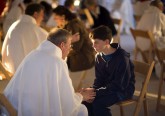Sunday Scripture: Making sense of our experience
May 8, 2011
By Terrance Callan
Third Sunday of Easter: Acts 2:14, 22-33; 1 Peter 1:17-21; Luke 24:13-35.
We often have difficulty understanding a new or unexpected experience. We recognize that something has happened to us, but we do not know exactly what it is. It is only when we place it in a framework of interpretation that we fully understand our experience. This is what happened when Jesus’ earliest followers experienced His resurrection from the dead.
The reading from the Gospel according to Luke is a story about how two disciples of Jesus recognized that He had been raised from the dead in the course of a journey to Emmaus. As they went on their way, Jesus walked with them, but they did not know who He was. They had heard of the discovery of Jesus’ empty tomb, but it apparently had not led them to believe that Jesus had been raised. One reason for this may be that it made no sense to them for Jesus to be crucified and then raised from the dead. His crucifixion seemed to mean the end of all the hopes they had had for Him. They say, “We were hoping that He would be the one to redeem Israel,” but they have now abandoned that hope. And talk of resurrection doesn’t seem to alter the situation.
Jesus leads them in two steps to look at this in a different way. First He shows the disciples that His death and resurrection was precisely what God had promised in the Scriptures. He asks them, “Was it not necessary that the Christ should suffer these things and enter into His glory?” And then “He interpreted to them what referred to Him in all the Scriptures.”
In this way He corrected their previous understanding of God’s plan of salvation. Previously the disciples had interpreted Scripture in such a way that Jesus’ crucifixion disqualified Him from being the Messiah, and resurrection had no meaning. Now Jesus showed them that, properly understood, Scripture promised the death and resurrection of the Messiah.
Having given the disciples a way to see that His death and resurrection make sense, Jesus takes a second step to reveal His resurrection to them. He shows them that He is alive and with them now. When Jesus sat down to eat with the disciples, “He took bread, said the blessing, broke it, and gave it to them.” As He did so, the disciples recognized Him as Jesus and He vanished. In order to believe that Jesus had been raised, the disciples first had to understand that Jesus’ death and resurrection was meaningful; then they could see Him in their midst.
The readings from the Acts of the Apostles and the First Letter of Peter give us further understanding of how the death and resurrection of Jesus are meaningful. The reading from Acts is part of a speech made by Peter. In this passage he explains that God had foretold the resurrection of the Messiah in Psalm 16, where David says that God will not allow the “holy one to see corruption.” And the reading from the First Letter of Peter explains the meaning of Jesus’ crucifixion. The reading presents the death of Jesus as the sacrifice “of a spotless unblemished lamb,” “known before the foundation of the world,” whose blood was the means of our salvation.
The celebration of the Eucharist regularly renews our recognition of Jesus’ resurrection in somewhat the same way that the disciples on the road to Emmaus first came to this recognition. In the Liturgy of the Word we hear readings from Scripture that help us to see the meaning of Jesus’ death and resurrection and everything that flows from them. And in the Liturgy of the Eucharist we break the bread that is Jesus in order to know Him present among us. Our recognition of Jesus in our midst is not identical to that of the Emmaus disciples, but is no less real. And without this experience of Jesus in our midst we cannot easily affirm that God has raised Him from the dead.
Callan is a faculty member at the Athenaeum of Ohio.










